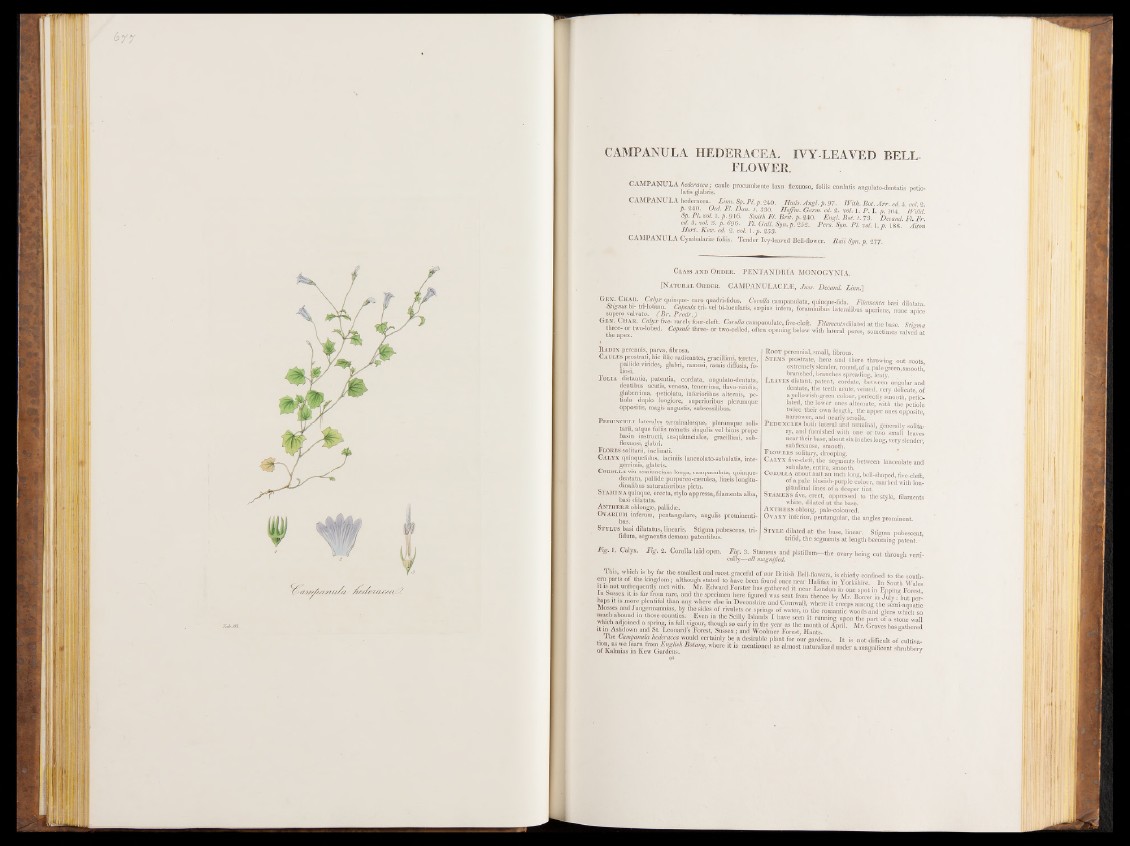
CAMPANULA HEDERACEA. IVY-LEAVED BELLFLOWER.
CAMPANULA hederacea; caule procumbente laxo flexuoso, foliis cordatis angulato-dentatis petio-
latis glabns.
CAMPANULA hederacea. Linn. Sp. PI. p. 240. Huds. A ngl. p . 97. With. B ot. A rr. ed. 4. ml. 2.
p. 240. Oed. Fl. Dan. t. 330. Hoffm. Germ. ed. 2. ml. 1. P., I. n. J04. Willd.
Sp. PI. ml. l. p. 916. Smith Fl: Brit. p. 240. Engl. Bot. t. 73. De cand.Fl.Fr.
ed. 3. m l S. p. 696. Fl. Gall. Syn. p. 252. Pers. Syn. Pi. ml. l .p . 188. Alton
Hort. Kew. ed. 2. ml. l .p . 253.
CAMPANULA Cymbal arise foliis. Tender Ivy-leaved Bell-flower. R ail S yn.p. 277.
Class a n d Or d e r . PENTANDRIA MONOGYNIA.
[N atural Or d e r . CAMPANULACEjE, J uss. Decand. L in n ]
GV .' tlu!n„tl“ e- raro quadri-fidus. Corolla campanulata. quinque-fida. Filamenta basi dilalata
Stigma in- tri-lobum. Capmiln: tn- vel bi-loculans, smpius infers, foraminibus lateralibus aperiens, nunc anice
supero valvatp. ( B r. P rodr.) - p
Ge n . Ch a r . Calyx'five- rarely four-cleft. Corolla cam pan ulate, five-cleft. Filaments dilated a t the base. Stigma
theapex tW° ’ °bed' CaPsule three_ or two-celled, often opening below with lateral pores, sometimes valved at
R adix perennis, parva, fibrosa.
Caules prostrati, hie illic radicantes, gracillimi, teretes,
pallide virides, glabri, ramosi, ramis diffusis, fo-
Folia distantia, patentia, cordata, angulato-dentata, I
dentibus acutis, venosa, tenerrima, flavo-viridia,
glaberrima, -petiolata, inferioribus alternis, pe-
tiolo duplo longiore, superioribus plerumque
oppositis, magis angustis, subsessilibus.
PEDUNCULI laterales terminalesque, plerumque soli-
tarii, atque foliis minutis singulis vel binis prope
basin instructi, sesquiunciales, gracillimi, sub-
. flexuosi, glabri.
F lores solitarii, inclinati.
Calyx quinquefidus, laciniis lanceolato-subulatis, inte-
gerrimis, glabris.
Corolla vix semiunciam longa, campanulata, quinque-
dentata, pallide purpureo-casrulea, lineis longitu-
dinalibus saturatioribus picta.
Stamina quinque, erecta, stylo appressa, filamenta alba,
basi dilatata.
An t h e r s oblongos, pallid se.
Ovarium inferum, pentangulare, angulis prominenti-
bus.
Stylus basi dilatatus, linearis. Stigma pubescens, tri-
fidum, segmentis demum patentibus.
Root perennial, small, fibrous.
Stems prostrate, here and there throwing out roots,
extremely slender, round, of a pale green, smooth’
branched, branches spreading, leafy.
Leaves distant, patent, cordate, between angular and
dentate, the teeth acute, veined, very delicate, of
a yellowish-green colour, perfectly smooth, petio-
lated, the lower ones alternate, with the petiole
twice their own length, the upper ones opposite,
P eduncles both lateral and terminal, generally solitary,
and furnished with one or two small leaves
near their base, about six incheslong, very slender
subflexuose, smooth.
F lowers solitary, drooping.
Calyx five-cleft, the segments between lanceolate and
subulate, entire, smooth. '
Corolla about half an inch long, bell-shaped, five-cleft,
of a pale blueish-purple colour, marked with longitudinal
lines of a deeper tint.
Stamews five, erect, oppressed to the style, filaments
white, dilated a t the base.
Anthers oblong, pale-coloured.
Ovary inferior, pentangular, the angles prominent.
Styl e dilated at the base, linear.. Stigma pubescent,
trifid, the segments a t length becoming paten t.-’
Fig. 1, Calyx. Fig. S. Corolla laid open. Fir. S. Stamens and pistillnm—the ovary being cut through vertically—
all magnified.
B f M M f f l I § S 1 | “ d most graceful of our British Bell-flowers, is chiefly confined to the southern
parts of the kingdom, although stated to have been found once near Halifax in Yorkshire. In South Wales
it is not unfrequenUy met with. Mr. Edward Forster has gathered it near London in one spot in Epping Forest
In Sussex it is far from rare, and the specimen here figured was sent from thence by Mr. Borrer in July but ner-
haps it is more plentiful than any where else in Devonshire and Cornwall, where it creeps among the semi-aquatic
Mosses and Jungermanmas, by the sides of rivulets or springs of water, in the romantic woods and glens which so
much abound in those counties. Even in the Scilly Islands I have seen it running upon the part of a stone w S
A M d a nP«1.n?r mfull.’ ,gn ur’ lllo“ghso early in the year as the month of April. Mr.it m Ashdown and St. Leonard s Forest, Sussex; and Woolmer Forest, Hants. Graves has gathered
The Campanula licdoracca would certainly be a desirable plant for our gardens. I t is not difficult o f cultiva-
of Kataiiw h i'Kmv G o d in s '‘ S °“‘"1/’ where “ ls meBti™ ed as almost naturalized under a magnificent shrubbery